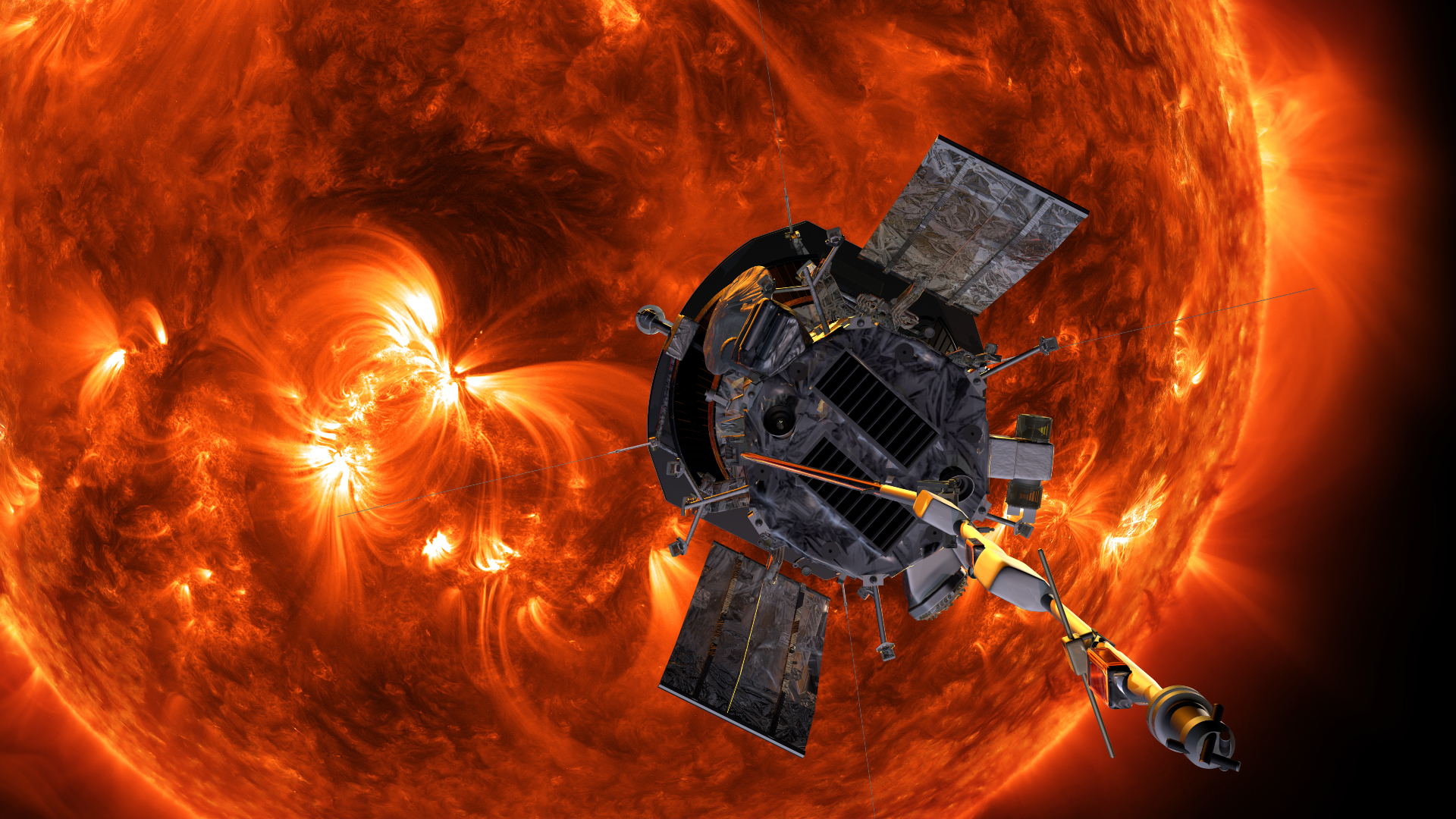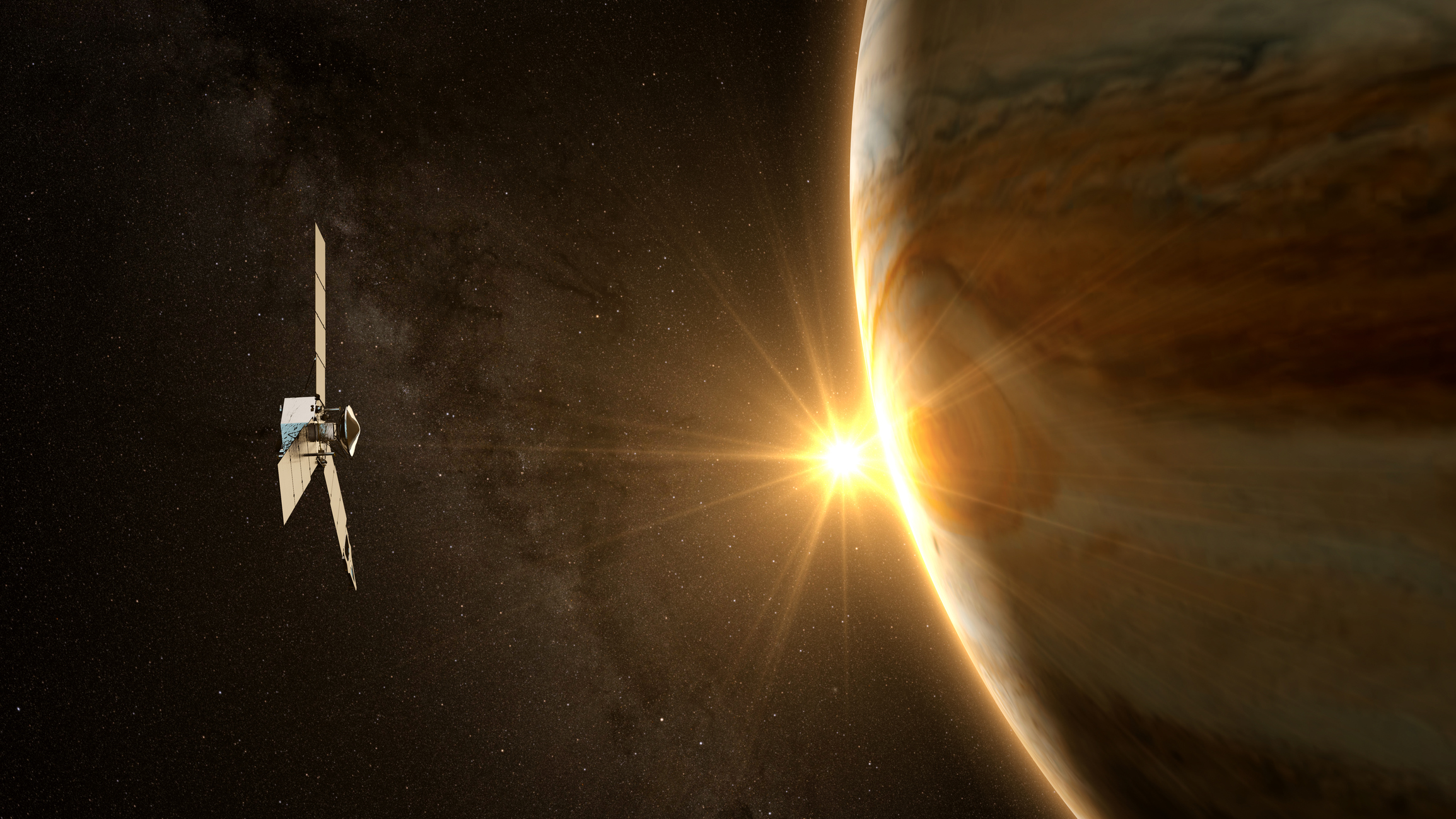How long does it take to get to Jupiter?
We explore how long it takes to get to Jupiter and the factors that affect the journey to the gas giant.

If you wanted to travel to Jupiter, how long would it take? The answer depends on a number of factors ranging from the positions of Earth and Jupiter to the technology that would propel you there.
Here we take a look at how long a trip to Jupiter would take using available technology and explore the travel times of previous missions to the Jovian neighborhood.
Currently, the spacecraft that took the shortest amount of time to reach Jupiter was NASA's New Horizons, zipping over to the gas giant in 405 days, or 1 year, 1 month and 9 days for a 2007 flyby.
Related: Jupiter missions: Past, present and future
How far away is Jupiter?
To determine how long it would take to reach Jupiter, we must first know the distance between Earth and the gas giant.
Jupiter is the fifth planet from the sun but the distance between Earth and Jupiter is constantly changing as they orbit the sun in elliptical, or oval-shaped paths.
When the two planets are at their closest point to one another, the distance to Jupiter is 365 million miles (588 million kilometers). The average distance between Earth and Jupiter is 444 million miles (714 million km), according to the science communication site The Nine Planets. At the farthest point in its orbit, the gas giant lies 601 million miles (968 million km) away.
Breaking space news, the latest updates on rocket launches, skywatching events and more!
How long would it take to travel to Jupiter at the speed of light?
Light travels at approximately 186,282 miles per second (299,792 km per second). Therefore, a light shining from Jupiter would take the following amount of time to reach Earth (or vice versa):
- Closest approach: 33 minutes
- Farthest approach: 54 minutes
- Average distance: 40 minutes
Fastest spacecraft so far
The fastest spacecraft is NASA's Parker Solar Probe, which keeps breaking its own speed records as it moves closer to the sun. On Nov 21, 2021, the Parker Solar Probe reached a top speed of 101 miles (163 kilometers) per second during its 10th close flyby of our star, which translates to an eye-watering 364,621 mph (586,000 kph). According to a NASA statement, when the Parker Solar Probe comes within 4 million miles (6.2 million kilometers) of the solar surface in December 2024, the spacecraft's speed will top 430,000 miles per hour (692,000 km/h)!
So if you were theoretically able to hitch a ride on the Parker Solar Probe and take it on a detour from its sun-focused mission to travel in a straight line out to Jupiter, traveling at the speeds the probe reaches during its 10th flyby (101 miles per second), the time it would take you to get to Jupiter would be:
- Closest approach: 42 days
- Farthest approach: 69 days
- Average distance: 51 days
The problems with calculating travel times to Jupiter
Of course, the problem with the previous calculations is that they measure the distance between the two planets as a straight line. If you were to travel between Earth and Jupiter when they are at their farthest distance apart, the trip would involve a path directly through the sun; therefore any spacecraft would have to move in orbit around the solar system's star.
Although this isn't a problem for a trip made during the two planets' closest approach, when they are both on the same side of the sun, the trip is not without complications. The previously calculated travel times also assume that the two planets remain at a constant distance; that is, when a probe is launched from Earth while the two planets are at their closest approach, Jupiter would remain the same distance away over the period of time it takes the probe to reach the gas giant.
In reality, however, the planets are moving at different rates during their orbits around the sun. Engineers must calculate the ideal orbits for sending a spacecraft from Earth to Jupiter. Like throwing a dart at a moving target from a moving vehicle, they must calculate where the planet will be when the spacecraft arrives, not where it is when it leaves Earth.
It's also not feasible to travel as fast as you can possibly go if your aim is to eventually orbit your target planet. Spacecraft need to arrive slowly enough to be able to perform orbit insertion maneuvers and not just zip straight past their destinations.
Engineers' calculations factor in not only the distance needed to travel but also the fuel efficiency of each particular spacecraft. Long-distance trips use gravity assist maneuvers to slingshot a spacecraft past planetary bodies and "steal" some of a planet's or other body's momentum to give the spacecraft a helpful nudge towards their intended destination. NASA's Jupiter explorer Juno performed an Earth flyby two years after its launch in order to boost the spacecraft's speed so that it could reach the gas giant, according to NASA. ESA's Jupiter Icy Moons Explorer (JUICE) mission will receive three gravity assists from Earth and one from Venus before it reaches the Jovian neighborhood.
How long do missions take to get to Jupiter?
Here is a list of how long it took previous missions to reach Jupiter as well as the estimated travel time for upcoming missions. Note how much longer the travel time is for missions that orbited Jupiter (e.g. Galileo and Juno) compared to those launched with the aim of sailing straight past.
- Pioneer 10: 642 days, or 1 year 9 months and 2 days
- Pioneer 11: 606 days, or 1 year 7 months and 27 days
- Voyager 1: 546 days, or 1 year and 6 months
- Voyager 2: 688 days, or 1 year, 10 months and 19 days
- Galileo: 2,241 days, or 6 years, 1 month and 19 days
- Ulysses: 490 days, or 1 year, 4 months and 2 days
- Cassini-Huygens: 1,172 days, or 3 years, 2 months and 15 days
- New Horizons: 405 days or 1 year, 1 month and 9 days
- Juno: 1,796 days or 4 years and 11 months
Upcoming missions estimated travel time:
- JUICE: 8 years
- Europa Clipper: 5 years and 6 months
Additional resources
Learn more about the missions that have ventured to Jupiter with these resources from NASA. Explore NASA's Juno mission in more detail here on their official mission page. What if we actually made it to Jupiter? Check out this article from Business Insider that explains what would happen if humans tries to land on the gas giant.
Bibliography
Juno Earth flyby. NASA. Retrieved April 12, 2023, from https://www.nasa.gov/mission_pages/juno/earthflyby.html#.ZDa0f3bMKUl
Hatfield, M. (2021, November 10). Space dust presents opportunities, challenges as Parker solar probe speeds back toward the sun. NASA. Retrieved April 12, 2023, from https://blogs.nasa.gov/parkersolarprobe/2021/11/10/space-dust-presents-opportunities-challenges-as-parker-solar-probe-speeds-back-toward-the-sun/
How far is Jupiter from Earth?: Distance, km, how long & facts. The Nine Planets. (n.d.). Retrieved April 12, 2023, from https://nineplanets.org/questions/how-far-is-jupiter-from-earth/
Juice's journey to Jupiter. ESA. (n.d.). Retrieved April 12, 2023, from https://www.esa.int/ESA_Multimedia/Images/2022/12/Juice_s_journey_to_Jupiter
Jupiter's statistics. Jupiter Statistics: Size, Orbit, Moons, Rings, Temperature, Mythology - Windows to the Universe. (n.d.). Retrieved April 12, 2023, from https://www.windows2universe.org/?page=%2Fjupiter%2Fstatistics.html

Daisy Dobrijevic joined Space.com in February 2022 having previously worked for our sister publication All About Space magazine as a staff writer. Before joining us, Daisy completed an editorial internship with the BBC Sky at Night Magazine and worked at the National Space Centre in Leicester, U.K., where she enjoyed communicating space science to the public. In 2021, Daisy completed a PhD in plant physiology and also holds a Master's in Environmental Science, she is currently based in Nottingham, U.K. Daisy is passionate about all things space, with a penchant for solar activity and space weather. She has a strong interest in astrotourism and loves nothing more than a good northern lights chase!


